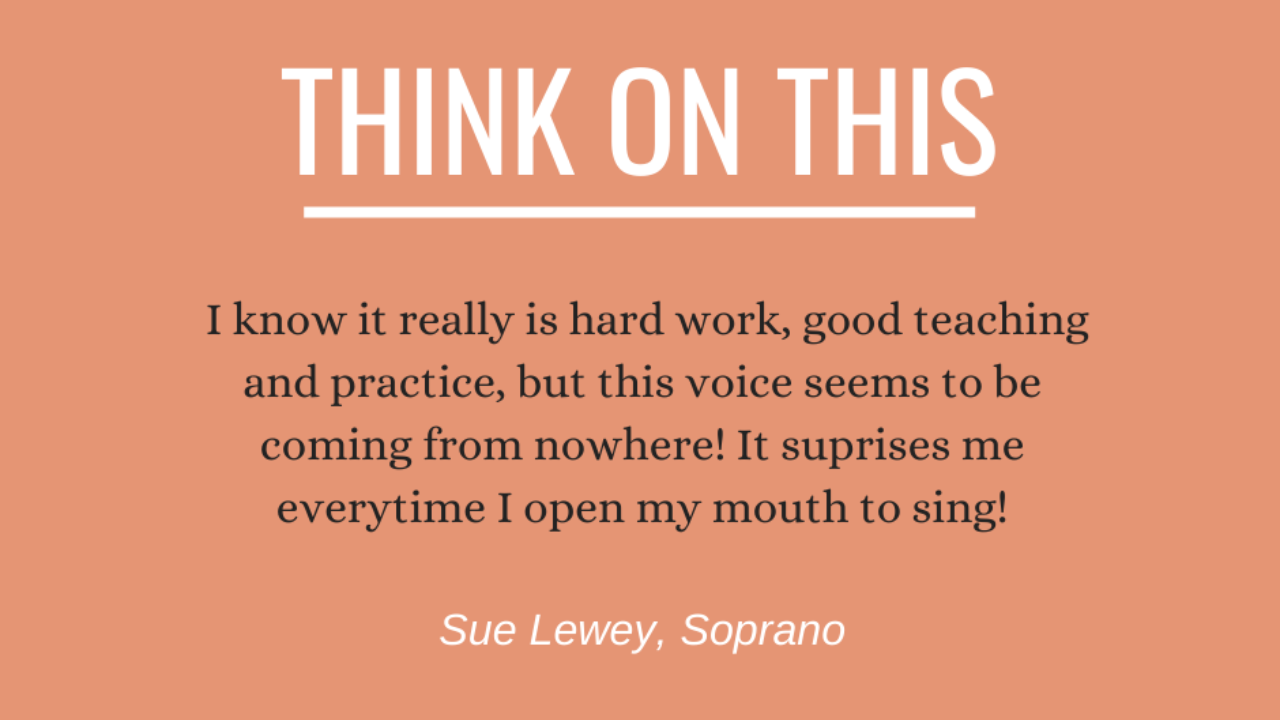Classical Singers: Learn more about Posture, Breath and Support

The more I teach, the more my own understanding as a singer grows.
A brilliant bonus from teaching something well is that you get to repeatedly learn the details and deep dive alongside your students and re-examine processes. Learning by doing. It's an excellent by-product - a wonderfully harmonious, serendipitous result.
Learning how to sing well, and with confidence is not a journey you can embark upon with impatience. It IS going to take time, especially if (as I am) you're invested in the longevity of the voice you already have.
Remember that the JOY is IN the journey, every step of the way, exploring the twists and turns - joining the dots as you go if you like.
What's in the video above... Posture, breath and support: go with the flow
The skill of singing well lies in patience, in practising little and often and with focus - and with great guidance or mentoring. A further secret also lies in appreciating what the body naturally wants and is equipped to do and by not ...
Breathing for singers: the ins and outs of it.

One of my teachers, Ilse Wolf, would always talk about ‘singing on the breath’.
Back then, I really didn’t have a clue what she actually meant. I would quietly listen while she explained, while she showed me diagrams in books that had pretty much been worn out by her fingertips over the years, as she pointed out the movement of AIRFLOW in the body as we breathe in and sing OUT.
But that was more than 30 years ago - and now I so GET everything she was sharing with me.
She meant: focus on the out-breath.
I didn’t understand then, but I’ve pursued my learning journey to the point where I now teach the same principles, just as she did then, to all my own singing students.
This infographic is a favourite of mine because it provokes thought. It also gives a hint of what is truly involved in the rather paradoxical ‘breathing mindset’.
But, in truth? It’s the tip of the iceberg.

There’s the fear that since breath is always escaping, it needs to be controlled by
- getting masses...
Singers: Love Your Larynx

The importance of learning all this vocal technique stuff is seeing the bigger picture.
I know lots of new singers are frustrated by vocal technique. In a PDF guide linked beneath my YouTube video, I outline 5 essential vocal tools that really matter in the long haul for vocal health. Muscle-memory-building tools that you rely on the most in the basic use and care of your unique voice. Go grab your free PDF copy and learn more.
Getting to grips with the basic vocal roadmap is paramount ie the scientific reasons why/how the vocal process works so you can work out what is going wrong or RIGHT at any time.

Of course, it isn’t as simple as that … well, it IS actually. In part.
A paradox!
I love to teach my students to self-scrutinise. I give them enough vocal instruction and learning to enable them to feel confident as they experiment along the way. It’s like watching a tight bud unfurl and come into bloom. It’s wonderful.
What’s of the greatest value is the discussion and...
Singing Tips for Beginners

Is singing a natural talent OR a learnt skill?
We all have a speaking voice and use our vocal folds/cords every single day, so you’re actually already familiar with how powering your voice feels. Learning to use your singing voice is just an extension of that same vocal process, using the same equipment. But with a certain set of learned basic skills. Ease your way in with one of my takeaways, a free PDF companion guide to this article: Need Help with Singing Basics.
Q: Can you teach yourself to sing or is it natural?
An education professor once said: “ Singing is more of a learnt skill than a talent.”
Singing does not lend itself well to self-teaching. Don’t make the mistake of thinking that you don’t need guidance when you’re learning. Another pair of ears to listen to you sing and watch how you’re achieving the sounds you make is not only important but vital. Many factors govern why you have the voice that you were born with (unique to you!) and a singing teacher’s job is to let...
Technique Tuesday Revised: Breathing - no need to push!


I first shared this infographic in May 2017 - inspired by a quote from The Voice Gym that I had seen on Twitter. Its message has to be one of the most golden statements when it comes to learning how to sing well.
But, what does it mean?
Misconceptions
When we think about breathing, everyone is usually very stressed about it as they get into their singing. It becomes a primary concern ie, will I have enough to get me through that phrase?
Will it last…?
There’s the fear that since breath is always escaping, it needs to be controlled by
- a) getting masses of it IN, and then
- b) to hold on to it, to control it for as long as possible, to nail that 4-bar phrase/that high note/the last note…
If we imagine gaining greater volume when we sing, there’s a psychological trigger that suggests to us that we must push more air to make it happen. But a greater volume achieved by pushing more air simply puts more stress on those little vocal folds (only 3-6 cells thick each) and leads to a...
Technique Tuesday : Yodelling

By ‘yodel’, singers, I don’t mean ‘a form of singing which involves repeated and rapid changes of pitch between the low-pitch chest register (or “chest voice”) and the high-pitch head register or falsetto.’
No no. This is different. Yet there are similarities …
The infographic alludes to those moments when you’re singing, everything is going smoothly until suddenly your voice does something weird. A ‘yodel’ or a ‘blip’ - a fluctuation in pitch/sound. It can feel embarrassing.
(A good analogy would be: when you’re driving - perhaps negotiating a speed change or a tricky corner - and you don’t quite change gear smoothly enough and the gearbox complains.)
Often when learning a craft or skill, (at any stage of development) there are moments when new muscle memories wrestle with the old, and the result can often mean a spot of spontaneous ‘yodelling’ happens.
There’s an imbalance going on somewhere in the mix.
The remedy lies in reapplication of very basic vocal technique principles a...







